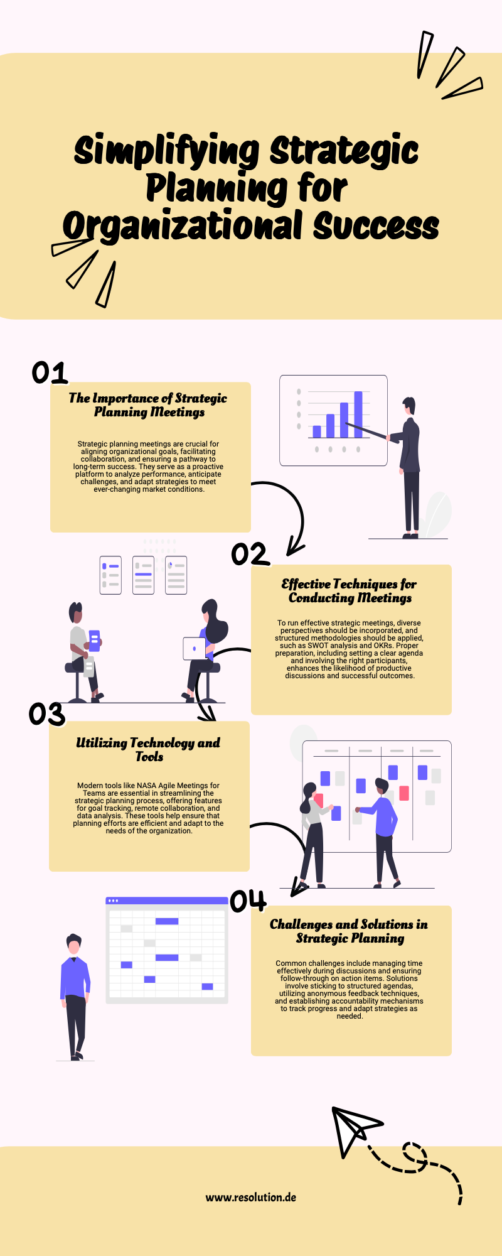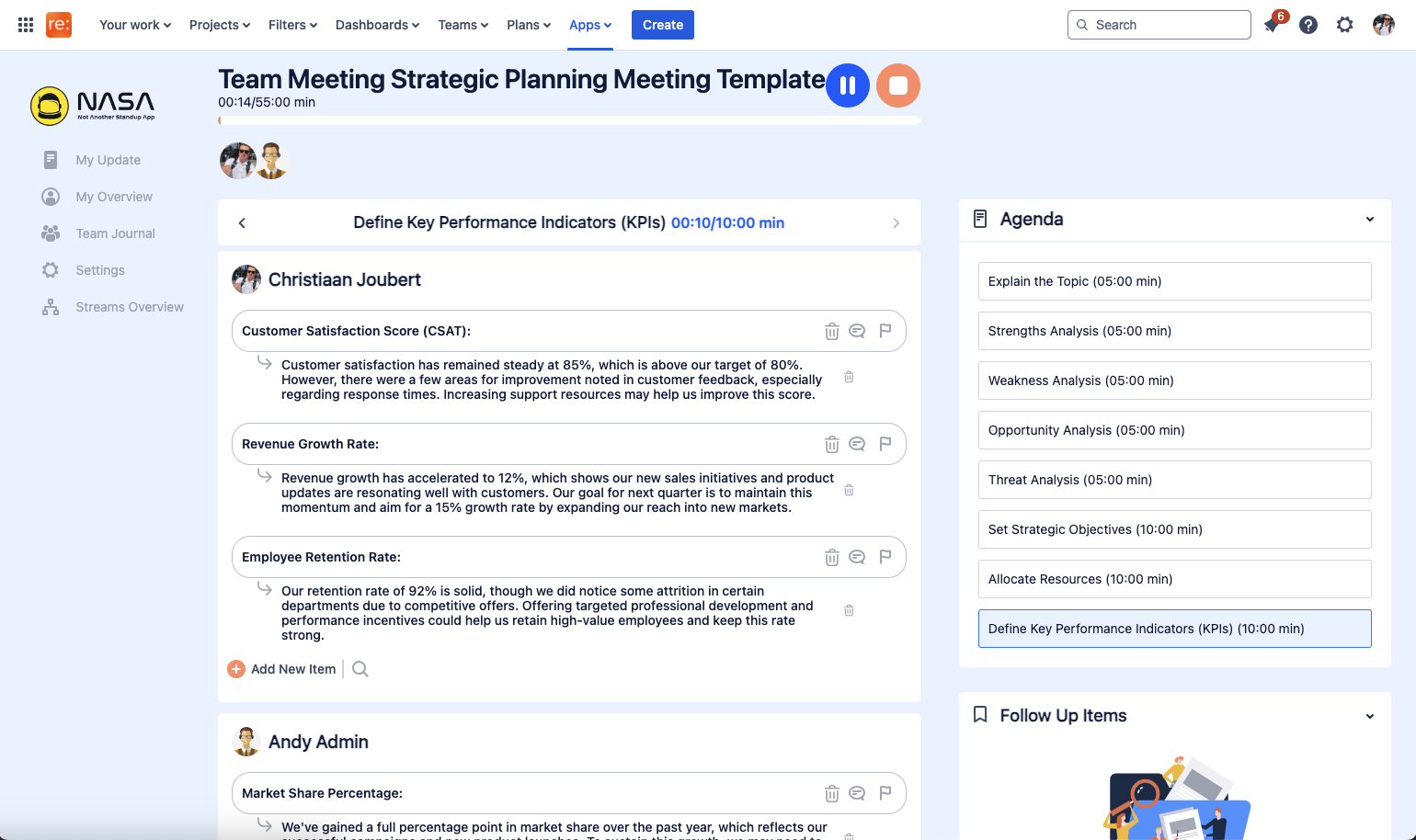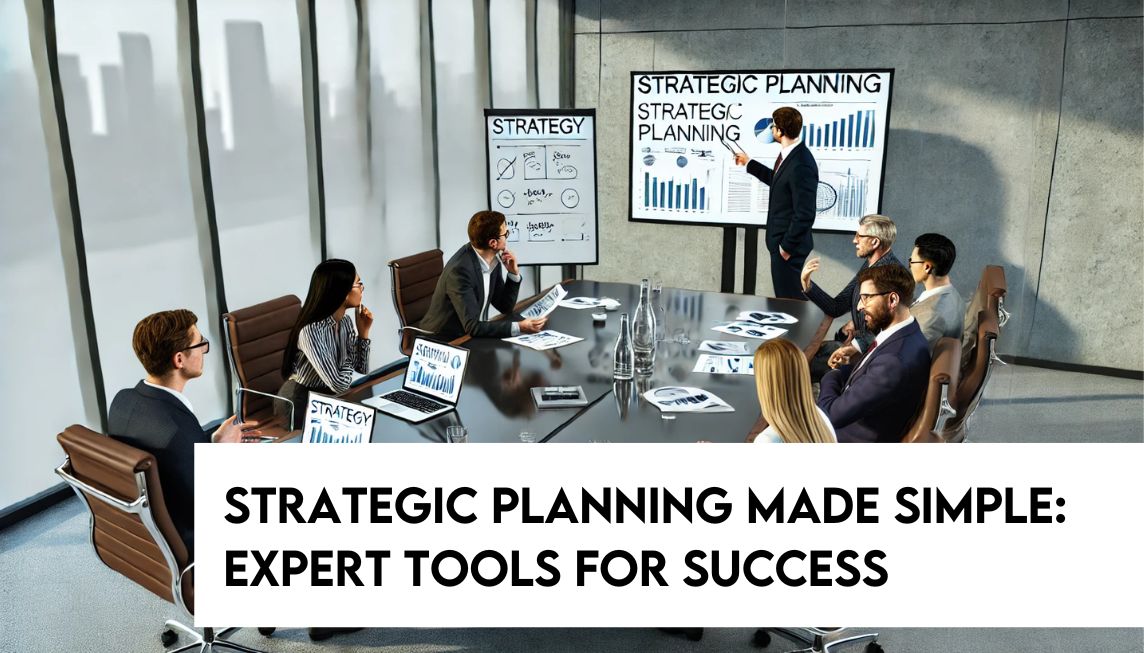Picture this: a leadership team gathers in a well-lit conference room, surrounded by charts and brainstorming tools, deeply engaged in shaping the organization’s future. This scene embodies the essence of successful strategic planning meetings—focused sessions where ideas turn into actionable goals and pathways for organizational success.
Strategic planning is a cornerstone of effective leadership and organizational growth. These meetings are more than discussions; they are pivotal opportunities to align visions, set priorities, and navigate the ever-changing market landscape. This article will explore how to conduct impactful strategic planning meetings, address common challenges, and leverage tools like NASA Agile Meetings for Teams to enhance your outcomes.
Key Takeaways
Strategic planning meetings are vital for aligning organizational objectives, fostering collaboration, and ensuring long-term success.
Effective meetings require preparation, diverse perspectives, and structured methodologies like SWOT analysis and OKRs.
Tools like NASA Agile Meetings for Teams streamline the process with goal tracking, strategy mapping, and remote collaboration features.
Addressing common challenges such as time management and follow-through ensures meeting outcomes translate into actionable progress.
1. Understanding Strategic Planning Meetings
Strategic planning meetings are structured discussions where leadership teams assess current performance, set long-term goals, and create actionable strategies to achieve them. These meetings often occur quarterly or annually and focus on aligning organizational efforts with overarching goals.
For example, consider a technology startup aiming to expand into new markets. During their strategic planning session, the leadership team might analyze market data, allocate resources for expansion, and set milestones for entering two new regions within a year.
By focusing on long-term objectives, these meetings integrate high-level vision with practical execution plans, ensuring that all efforts contribute to overarching goals.
Importance of Strategic Planning Meetings
Strategic planning meetings serve as the backbone of organizational success. They provide a proactive platform to anticipate challenges, allocate resources effectively, and adapt to external pressures.
For instance, a retail company facing rising e-commerce competition might use these meetings to pivot toward online strategies, redefining their approach to customer engagement.
When done effectively, strategic planning meetings:
Foster alignment across departments, ensuring everyone works toward shared objectives.
Enhance decision-making by grounding discussions in data and structured analysis.
Build organizational agility, enabling quick responses to market changes.
Key Objectives of a Strategic Planning Meeting
Strategic planning meetings revolve around three core goals:
Assessing the Current State: Analyze performance metrics, market trends, and internal strengths/weaknesses.
Defining Future Objectives: Establish SMART goals that align with the organization’s mission.
Formulating Actionable Strategies: Develop clear initiatives with defined responsibilities and timelines.
Example Techniques:
SWOT Analysis: Identify strengths, weaknesses, opportunities, and threats.
Balanced Scorecard: Align initiatives with vision and track performance.

Who Should Attend a Strategic Planning Meeting?
The success of strategic planning hinges on involving the right people:
C-Suite Executives: Provide overarching vision and strategic priorities.
Department Heads: Offer insights on operational feasibility and resource needs.
Key Managers: Bridge strategy and execution, ensuring realistic implementation.
External Consultants (when needed): Add specialized expertise and unbiased perspectives.
Diverse participation fosters cross-functional collaboration and ensures the strategic plan addresses all critical aspects of the organization.
Roles and Responsibilities
Effective strategic planning relies on clear roles:
Facilitator: Ensures smooth meeting flow, manages discussions, and resolves conflicts.
Executives: Define vision, approve strategies, and allocate resources.
Participants: Contribute insights, challenge assumptions, and commit to action plans.
For instance, a facilitator might guide a brainstorming session using PESTLE analysis, while participants analyze potential political and technological impacts on the business.
How to Conduct an Effective Strategic Planning Meeting
Preparation Steps
Preparation is key. Start by collecting relevant data such as market trends, performance reports, and customer feedback. Set a clear agenda with defined discussion points and objectives. If possible, share pre-reads to ensure participants come prepared.
Selecting the right venue is equally important. An offsite location can encourage creativity, while an onsite meeting room may provide convenience and access to necessary tools.
Facilitating the Meeting
Begin by establishing ground rules to foster a collaborative tone. Encourage open participation, ensuring both dominant voices and quieter members contribute. Utilize frameworks like Porter’s Five Forces or breakout sessions to explore key strategic issues deeply.
Creating Action Plans
Strategic management objectives should translate into concrete actions. Use methods like the Eisenhower Matrix to prioritize initiatives. Assign responsibilities, set deadlines, and define metrics for tracking progress. Document the business plan and communicate it across the organization.
Common Challenges and Solutions in Strategic Planning Meetings
Managing Time Effectively
Strategic meetings often run over time. To combat this, stick to a well-structured agenda, allocate time for each topic, and use a “parking lot” to defer off-topic discussions.
Encouraging Open Communication
Participants may hesitate to share controversial ideas. Combat this by using anonymous input methods or round-robin sharing. Skilled facilitation can also resolve conflicts and guide the group toward consensus.
Ensuring Follow-Through
One of the biggest pitfalls is failing to execute the plan. Establish accountability mechanisms like regular check-ins and performance dashboards to track progress. Flexibility is also key—adapt the plan as circumstances change.
Tools and Techniques for Strategic Planning Meetings
Digital Collaboration Tools
Tools like NASA Agile Meetings for Teams offer features that streamline strategic planning, such as goal tracking, data analysis, and remote participation capabilities. Visualization tools like Gantt charts or mind mapping software also aid in strategy development.

Popular Strategic Planning Techniques
SWOT Analysis: Identify internal and external factors affecting the organization.
OKRs: Set ambitious goals with measurable outcomes.
Scenario Planning: Prepare for potential future scenarios to ensure adaptability.
Tailor these techniques to fit your organization’s culture and challenges. For example, a healthcare organization might use scenario planning to anticipate regulatory changes.
Summary
Strategic planning meetings are the foundation of organizational excellence. By preparing effectively, fostering collaboration, and following through on actionable plans, you can ensure these sessions drive meaningful progress. Leveraging tools like NASA Agile Meetings for Teams further enhances your ability to adapt and thrive in a competitive landscape.
Share your experiences or challenges with strategic planning in the comments below, and connect with me on social media for more insights. Let’s elevate your organization’s strategic initiatives together!
Frequently Asked Questions
Why are strategic planning meetings important?
Strategic planning aligns organizational efforts with long-term goals, fostering proactive decision-making and adaptability.Who should attend?
Key decision-makers, such as executives, managers, and sometimes external consultants, should participate.How can time be managed effectively?
Set a clear agenda, timebox discussions, and handle off-topic issues separately.What are popular techniques?
SWOT analysis, Balanced Scorecard, OKRs, and Scenario Planning are commonly used frameworks.How can follow-through be ensured?
Establish accountability with regular reviews, assigned responsibilities, and adaptable strategies.
Explore Strategic Planning Solutions
Effective strategic planning isn’t just about discussions—it’s about execution. To enhance your strategic meetings and drive results, try NASA Agile Meetings for Teams, a tool designed to streamline collaboration, goal tracking, and strategy execution.
See NASA in Action: Schedule a Demo to explore its features in real time.
Learn More: Visit our Product Page for detailed insights into how NASA can transform your meetings.
Download Now: Access NASA Agile Meetings for Teams directly from the Atlassian Marketplace to get started today.
Ready to elevate your strategic planning process? Explore these resources and take your first step toward more productive and impactful meetings.
Mastering Strategic Planning for Successful Business Outcomes
Understanding Strategic Planning
Strategic planning is a process that defines an organization’s vision and goals, and identifies the sequence of steps to achieve them.
It is a forward-looking process that differs from traditional business planning, which focuses on short-term, tactical goals.
The product of strategic planning is a strategic management plan, which is a document that outlines the organization’s goals and objectives.
The Benefits of Strategic Planning
Strategic planning provides direction and guidance for an organization, helping it to achieve its goals.
It offers a roadmap for achieving business goals, and helps to ensure that the organization is on track to reach its objectives.
Without strategic planning efforts, an organization may struggle to achieve its goals, and may lack direction and focus.
Strategic Planning in Modern Business
The landscape of strategic planning has undergone significant shifts in recent years, driven by innovations in technology and socioeconomic upheavals.
Modern considerations for strategic planning include the need for flexibility and resilience, as well as the importance of digital transformation and sustainability.
Embracing Digital Transformation
Digital transformation is a critical component of strategic planning, and organizations must integrate digital capabilities into their strategic planning processes to remain competitive.
Digital transformation can help organizations to innovate, boost efficiency, and enhance customer experiences.
It requires a strategic approach to leveraging technology to drive business outcomes.
Sustainability and Social Responsibility
Sustainability and social responsibility are emerging as central considerations in strategic planning, and organizations must align their strategies with environmental, social, and governance (ESG) criteria.
Incorporating sustainability and social responsibility into strategic planning can help organizations to innovate and connect with eco-conscious consumers and stakeholders.
It requires a strategic approach to managing the organization’s impact on the environment and society.
Developing a Strategic Plan
The strategic planning process typically involves five steps: identify, prioritize, develop, implement, and update.
The process requires clear communication, stakeholder engagement, and a willingness to adapt and adjust the plan in response to changing circumstances.
Setting Strategic Objectives
Strategic objectives are specific, measurable, achievable, relevant, and time-bound (SMART) goals that align with the organization’s vision and mission.
They provide a clear direction for the organization and help to focus efforts on achieving key outcomes.
Strategic objectives should be aligned with the organization’s overall strategy and goals.
Creating a Strategic Plan
A strategic plan is a document that outlines the organization’s goals, objectives, and strategies for achieving them.
It should include a clear vision statement, mission statement, and set of strategic objectives.
The plan should also outline the key initiatives and actions required to achieve the strategic objectives.
Strategic Management and Execution
Strategic management is the implementation of the strategy, and involves identifying benchmarks, allocating resources, and providing leadership to realize established goals.
Strategy execution is the systematic implementation of a strategy, and is often synonymous with strategic management.
Effective strategic management and execution require ongoing monitoring and adjustment to ensure the organization remains aligned with its goals and objectives.
Tools and Frameworks for Strategic Planning Process
A strategy map is a planning tool or template used to help stakeholders visualize the complete strategy of a business as one interrelated graphic.
It focuses on four major business areas or categories: financial, customer, internal business processes, and learning and growth.
A Balanced Scorecard (BSC) is a framework that examines four key perspectives: financial, customer, internal business processes, and learning and growth.
Best Practices for Strategic Planning Process
A good planning framework should be comprehensive, structured, and easy to understand.
It should include a clear definition of the organization’s mission, vision, and goals, as well as a plan for achieving those goals.
A good strategic planning framework should be flexible and adaptable, and should be able to evolve as the organization’s needs and circumstances change.
Building a Smarter Strategic Planning Process
A work management platform plays a pivotal role in connecting company objectives to daily work and ensuring every task and project is directly tied to broader company goals.
It streamlines workflow, enhances team productivity, and aligns every action with strategic objectives, allowing teams to drive greater impact and help the company move toward goals more effectively.
Conclusion
Strategic planning is a critical process for organizations to achieve their goals and objectives.
It requires a clear understanding of the organization’s vision, mission, and goals, as well as a willingness to adapt and adjust the plan in response to changing circumstances.
By following best practices and using effective tools and frameworks, organizations can develop a smarter strategic plan that drives business outcomes and achieves success.




